Organizational Behavior Assignment: Diversity at Workplace
VerifiedAdded on 2021/06/16
|9
|2745
|147
Annotated Bibliography
AI Summary
This annotated bibliography examines the multifaceted impact of diversity in the workplace, drawing upon a range of scholarly sources to explore its significance for both organizations and employees. The paper highlights how diversity can increase profitability, minimize costs, and create a competitive advantage. It delves into the advantages of diversity management, emphasizing the importance of fostering a safe, fair, and inclusive environment where all employees have equal opportunities. The bibliography covers various aspects of workplace diversity, including cultural diversity, its effects on productivity, and the challenges faced by human resource management in handling issues like discrimination, conflict, and harassment. It also emphasizes the role of effective communication, strategic planning, and training programs in promoting a comprehensive and inclusive workplace, ultimately leading to improved employee performance, innovation, and organizational success.
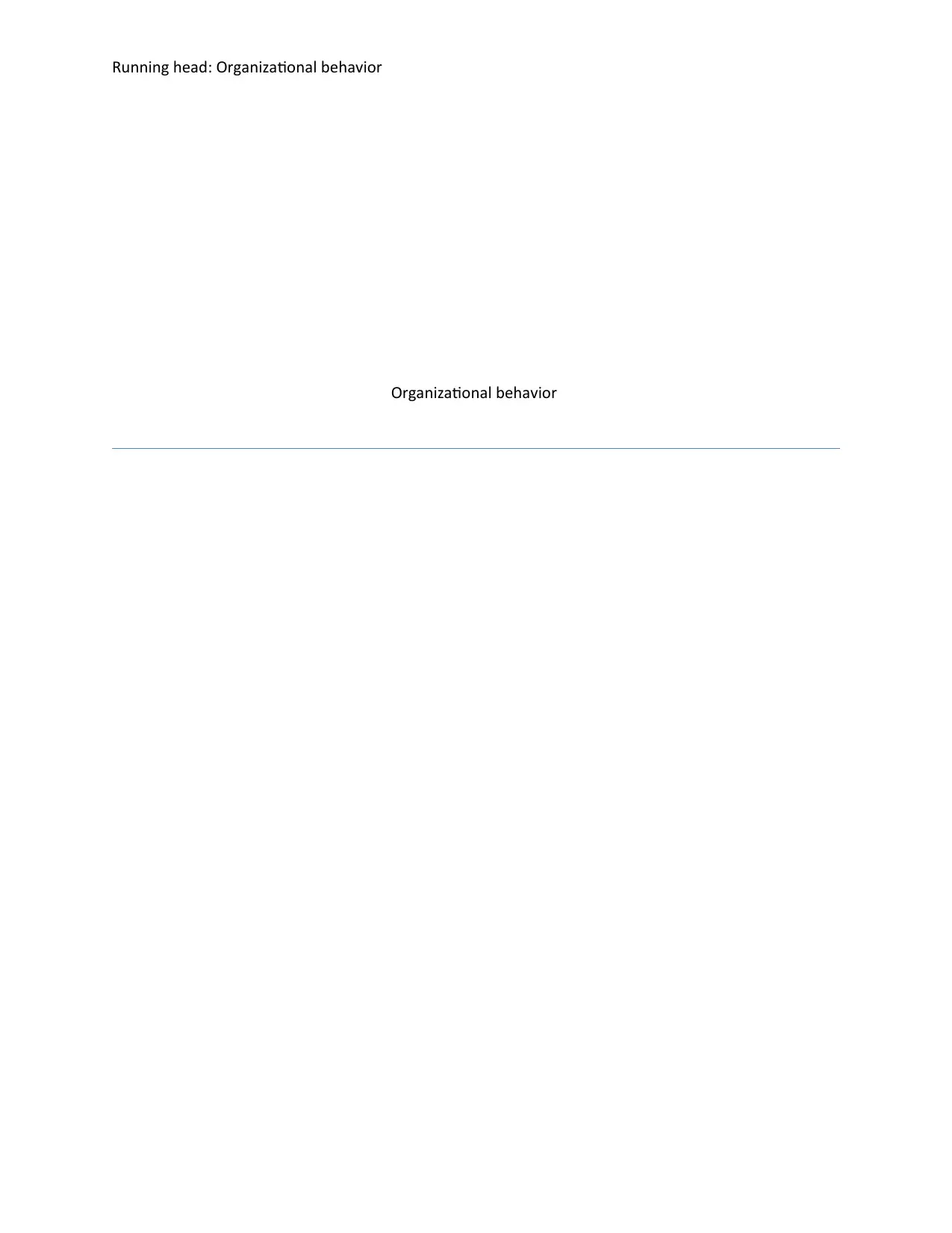
Running head: Organizational behavior
Organizational behavior
Organizational behavior
Paraphrase This Document
Need a fresh take? Get an instant paraphrase of this document with our AI Paraphraser
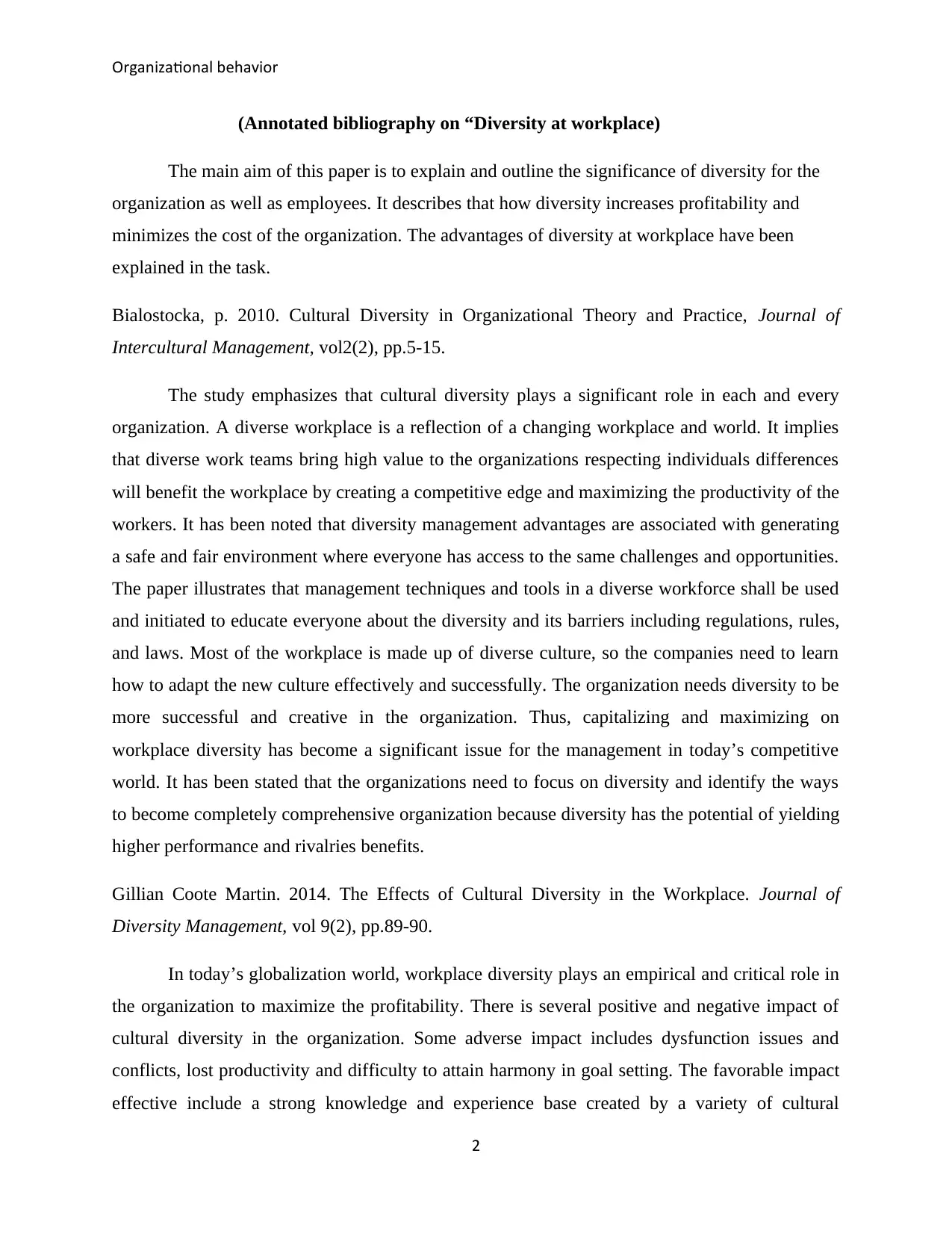
Organizational behavior
(Annotated bibliography on “Diversity at workplace)
The main aim of this paper is to explain and outline the significance of diversity for the
organization as well as employees. It describes that how diversity increases profitability and
minimizes the cost of the organization. The advantages of diversity at workplace have been
explained in the task.
Bialostocka, p. 2010. Cultural Diversity in Organizational Theory and Practice, Journal of
Intercultural Management, vol2(2), pp.5-15.
The study emphasizes that cultural diversity plays a significant role in each and every
organization. A diverse workplace is a reflection of a changing workplace and world. It implies
that diverse work teams bring high value to the organizations respecting individuals differences
will benefit the workplace by creating a competitive edge and maximizing the productivity of the
workers. It has been noted that diversity management advantages are associated with generating
a safe and fair environment where everyone has access to the same challenges and opportunities.
The paper illustrates that management techniques and tools in a diverse workforce shall be used
and initiated to educate everyone about the diversity and its barriers including regulations, rules,
and laws. Most of the workplace is made up of diverse culture, so the companies need to learn
how to adapt the new culture effectively and successfully. The organization needs diversity to be
more successful and creative in the organization. Thus, capitalizing and maximizing on
workplace diversity has become a significant issue for the management in today’s competitive
world. It has been stated that the organizations need to focus on diversity and identify the ways
to become completely comprehensive organization because diversity has the potential of yielding
higher performance and rivalries benefits.
Gillian Coote Martin. 2014. The Effects of Cultural Diversity in the Workplace. Journal of
Diversity Management, vol 9(2), pp.89-90.
In today’s globalization world, workplace diversity plays an empirical and critical role in
the organization to maximize the profitability. There is several positive and negative impact of
cultural diversity in the organization. Some adverse impact includes dysfunction issues and
conflicts, lost productivity and difficulty to attain harmony in goal setting. The favorable impact
effective include a strong knowledge and experience base created by a variety of cultural
2
(Annotated bibliography on “Diversity at workplace)
The main aim of this paper is to explain and outline the significance of diversity for the
organization as well as employees. It describes that how diversity increases profitability and
minimizes the cost of the organization. The advantages of diversity at workplace have been
explained in the task.
Bialostocka, p. 2010. Cultural Diversity in Organizational Theory and Practice, Journal of
Intercultural Management, vol2(2), pp.5-15.
The study emphasizes that cultural diversity plays a significant role in each and every
organization. A diverse workplace is a reflection of a changing workplace and world. It implies
that diverse work teams bring high value to the organizations respecting individuals differences
will benefit the workplace by creating a competitive edge and maximizing the productivity of the
workers. It has been noted that diversity management advantages are associated with generating
a safe and fair environment where everyone has access to the same challenges and opportunities.
The paper illustrates that management techniques and tools in a diverse workforce shall be used
and initiated to educate everyone about the diversity and its barriers including regulations, rules,
and laws. Most of the workplace is made up of diverse culture, so the companies need to learn
how to adapt the new culture effectively and successfully. The organization needs diversity to be
more successful and creative in the organization. Thus, capitalizing and maximizing on
workplace diversity has become a significant issue for the management in today’s competitive
world. It has been stated that the organizations need to focus on diversity and identify the ways
to become completely comprehensive organization because diversity has the potential of yielding
higher performance and rivalries benefits.
Gillian Coote Martin. 2014. The Effects of Cultural Diversity in the Workplace. Journal of
Diversity Management, vol 9(2), pp.89-90.
In today’s globalization world, workplace diversity plays an empirical and critical role in
the organization to maximize the profitability. There is several positive and negative impact of
cultural diversity in the organization. Some adverse impact includes dysfunction issues and
conflicts, lost productivity and difficulty to attain harmony in goal setting. The favorable impact
effective include a strong knowledge and experience base created by a variety of cultural
2
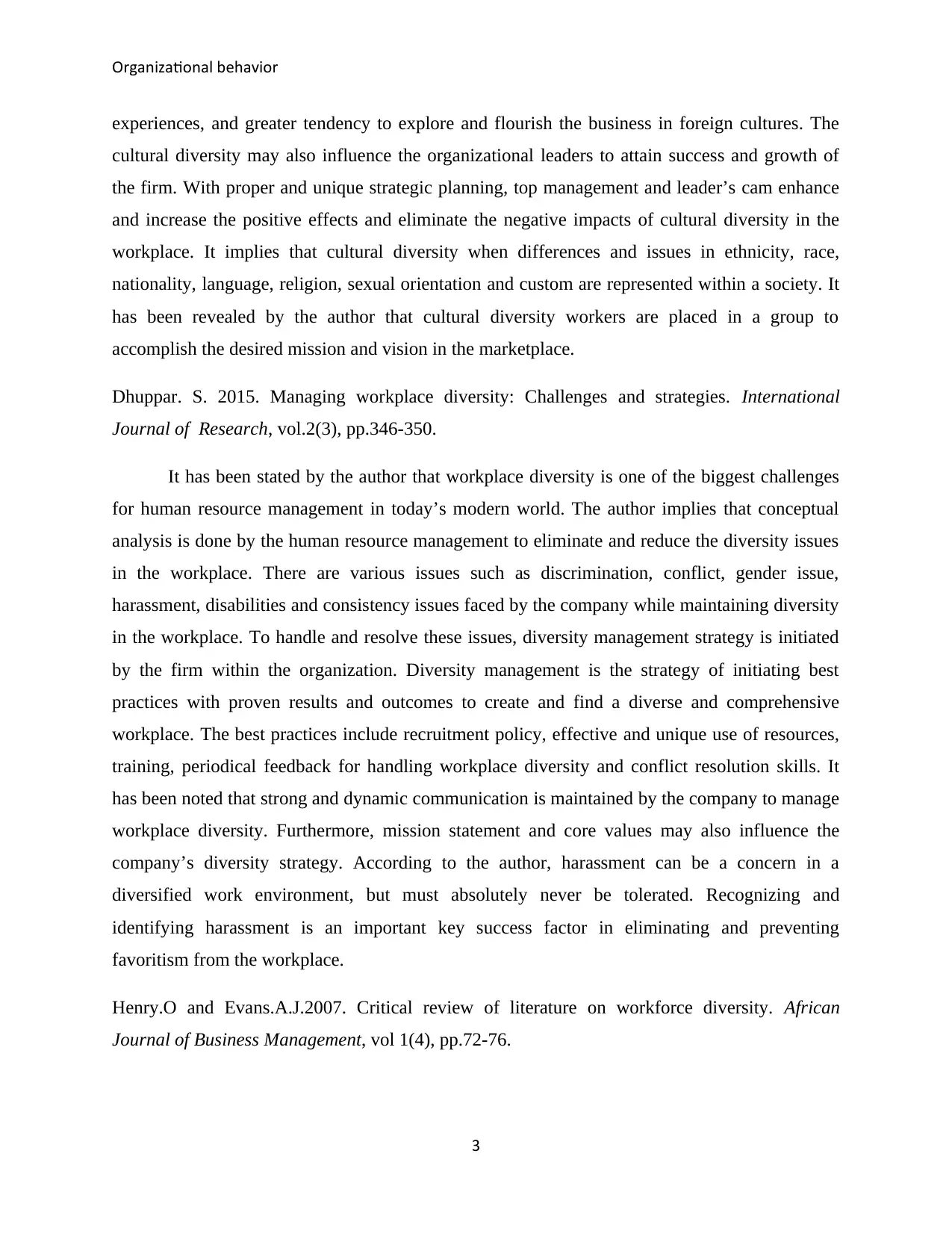
Organizational behavior
experiences, and greater tendency to explore and flourish the business in foreign cultures. The
cultural diversity may also influence the organizational leaders to attain success and growth of
the firm. With proper and unique strategic planning, top management and leader’s cam enhance
and increase the positive effects and eliminate the negative impacts of cultural diversity in the
workplace. It implies that cultural diversity when differences and issues in ethnicity, race,
nationality, language, religion, sexual orientation and custom are represented within a society. It
has been revealed by the author that cultural diversity workers are placed in a group to
accomplish the desired mission and vision in the marketplace.
Dhuppar. S. 2015. Managing workplace diversity: Challenges and strategies. International
Journal of Research, vol.2(3), pp.346-350.
It has been stated by the author that workplace diversity is one of the biggest challenges
for human resource management in today’s modern world. The author implies that conceptual
analysis is done by the human resource management to eliminate and reduce the diversity issues
in the workplace. There are various issues such as discrimination, conflict, gender issue,
harassment, disabilities and consistency issues faced by the company while maintaining diversity
in the workplace. To handle and resolve these issues, diversity management strategy is initiated
by the firm within the organization. Diversity management is the strategy of initiating best
practices with proven results and outcomes to create and find a diverse and comprehensive
workplace. The best practices include recruitment policy, effective and unique use of resources,
training, periodical feedback for handling workplace diversity and conflict resolution skills. It
has been noted that strong and dynamic communication is maintained by the company to manage
workplace diversity. Furthermore, mission statement and core values may also influence the
company’s diversity strategy. According to the author, harassment can be a concern in a
diversified work environment, but must absolutely never be tolerated. Recognizing and
identifying harassment is an important key success factor in eliminating and preventing
favoritism from the workplace.
Henry.O and Evans.A.J.2007. Critical review of literature on workforce diversity. African
Journal of Business Management, vol 1(4), pp.72-76.
3
experiences, and greater tendency to explore and flourish the business in foreign cultures. The
cultural diversity may also influence the organizational leaders to attain success and growth of
the firm. With proper and unique strategic planning, top management and leader’s cam enhance
and increase the positive effects and eliminate the negative impacts of cultural diversity in the
workplace. It implies that cultural diversity when differences and issues in ethnicity, race,
nationality, language, religion, sexual orientation and custom are represented within a society. It
has been revealed by the author that cultural diversity workers are placed in a group to
accomplish the desired mission and vision in the marketplace.
Dhuppar. S. 2015. Managing workplace diversity: Challenges and strategies. International
Journal of Research, vol.2(3), pp.346-350.
It has been stated by the author that workplace diversity is one of the biggest challenges
for human resource management in today’s modern world. The author implies that conceptual
analysis is done by the human resource management to eliminate and reduce the diversity issues
in the workplace. There are various issues such as discrimination, conflict, gender issue,
harassment, disabilities and consistency issues faced by the company while maintaining diversity
in the workplace. To handle and resolve these issues, diversity management strategy is initiated
by the firm within the organization. Diversity management is the strategy of initiating best
practices with proven results and outcomes to create and find a diverse and comprehensive
workplace. The best practices include recruitment policy, effective and unique use of resources,
training, periodical feedback for handling workplace diversity and conflict resolution skills. It
has been noted that strong and dynamic communication is maintained by the company to manage
workplace diversity. Furthermore, mission statement and core values may also influence the
company’s diversity strategy. According to the author, harassment can be a concern in a
diversified work environment, but must absolutely never be tolerated. Recognizing and
identifying harassment is an important key success factor in eliminating and preventing
favoritism from the workplace.
Henry.O and Evans.A.J.2007. Critical review of literature on workforce diversity. African
Journal of Business Management, vol 1(4), pp.72-76.
3
⊘ This is a preview!⊘
Do you want full access?
Subscribe today to unlock all pages.

Trusted by 1+ million students worldwide
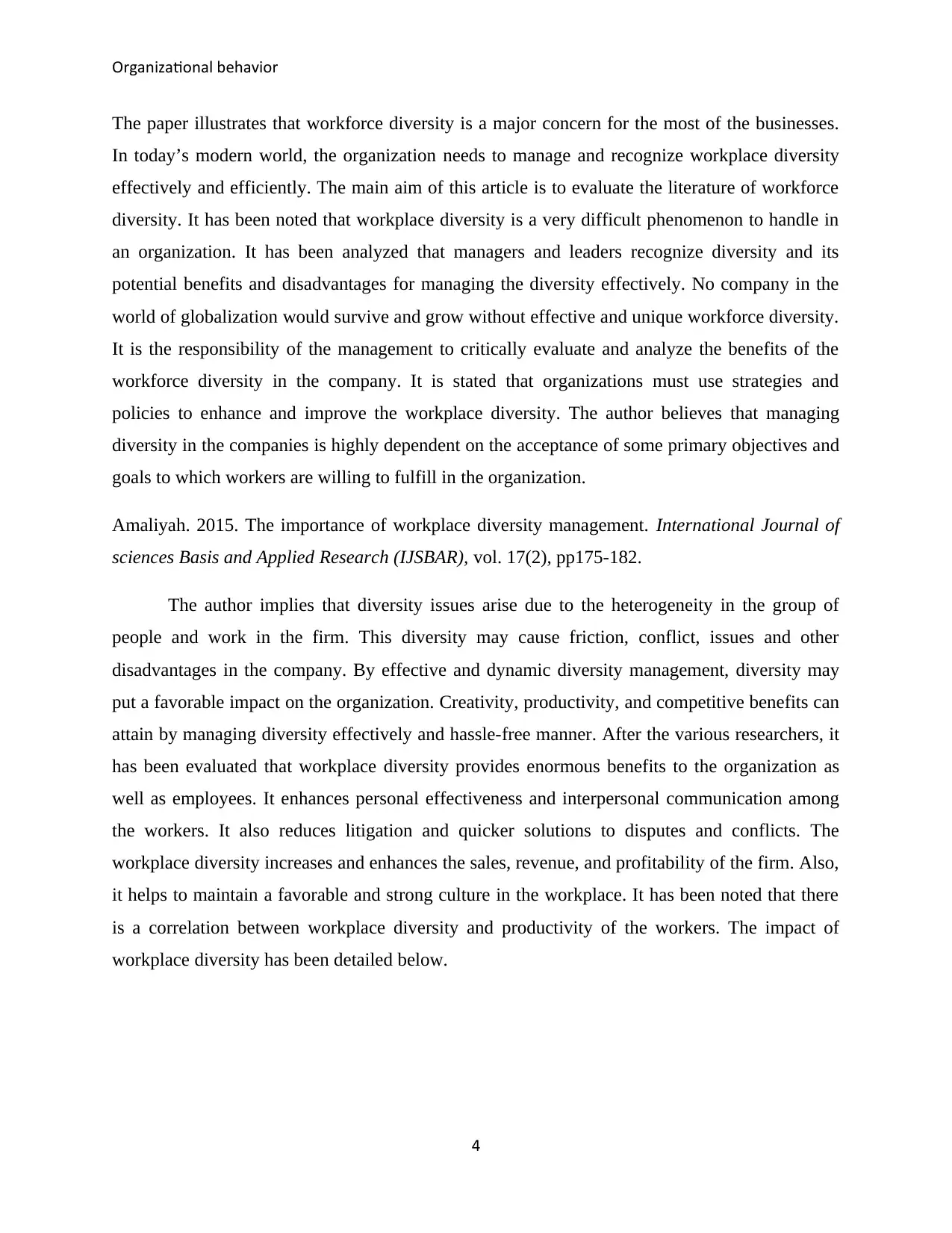
Organizational behavior
The paper illustrates that workforce diversity is a major concern for the most of the businesses.
In today’s modern world, the organization needs to manage and recognize workplace diversity
effectively and efficiently. The main aim of this article is to evaluate the literature of workforce
diversity. It has been noted that workplace diversity is a very difficult phenomenon to handle in
an organization. It has been analyzed that managers and leaders recognize diversity and its
potential benefits and disadvantages for managing the diversity effectively. No company in the
world of globalization would survive and grow without effective and unique workforce diversity.
It is the responsibility of the management to critically evaluate and analyze the benefits of the
workforce diversity in the company. It is stated that organizations must use strategies and
policies to enhance and improve the workplace diversity. The author believes that managing
diversity in the companies is highly dependent on the acceptance of some primary objectives and
goals to which workers are willing to fulfill in the organization.
Amaliyah. 2015. The importance of workplace diversity management. International Journal of
sciences Basis and Applied Research (IJSBAR), vol. 17(2), pp175-182.
The author implies that diversity issues arise due to the heterogeneity in the group of
people and work in the firm. This diversity may cause friction, conflict, issues and other
disadvantages in the company. By effective and dynamic diversity management, diversity may
put a favorable impact on the organization. Creativity, productivity, and competitive benefits can
attain by managing diversity effectively and hassle-free manner. After the various researchers, it
has been evaluated that workplace diversity provides enormous benefits to the organization as
well as employees. It enhances personal effectiveness and interpersonal communication among
the workers. It also reduces litigation and quicker solutions to disputes and conflicts. The
workplace diversity increases and enhances the sales, revenue, and profitability of the firm. Also,
it helps to maintain a favorable and strong culture in the workplace. It has been noted that there
is a correlation between workplace diversity and productivity of the workers. The impact of
workplace diversity has been detailed below.
4
The paper illustrates that workforce diversity is a major concern for the most of the businesses.
In today’s modern world, the organization needs to manage and recognize workplace diversity
effectively and efficiently. The main aim of this article is to evaluate the literature of workforce
diversity. It has been noted that workplace diversity is a very difficult phenomenon to handle in
an organization. It has been analyzed that managers and leaders recognize diversity and its
potential benefits and disadvantages for managing the diversity effectively. No company in the
world of globalization would survive and grow without effective and unique workforce diversity.
It is the responsibility of the management to critically evaluate and analyze the benefits of the
workforce diversity in the company. It is stated that organizations must use strategies and
policies to enhance and improve the workplace diversity. The author believes that managing
diversity in the companies is highly dependent on the acceptance of some primary objectives and
goals to which workers are willing to fulfill in the organization.
Amaliyah. 2015. The importance of workplace diversity management. International Journal of
sciences Basis and Applied Research (IJSBAR), vol. 17(2), pp175-182.
The author implies that diversity issues arise due to the heterogeneity in the group of
people and work in the firm. This diversity may cause friction, conflict, issues and other
disadvantages in the company. By effective and dynamic diversity management, diversity may
put a favorable impact on the organization. Creativity, productivity, and competitive benefits can
attain by managing diversity effectively and hassle-free manner. After the various researchers, it
has been evaluated that workplace diversity provides enormous benefits to the organization as
well as employees. It enhances personal effectiveness and interpersonal communication among
the workers. It also reduces litigation and quicker solutions to disputes and conflicts. The
workplace diversity increases and enhances the sales, revenue, and profitability of the firm. Also,
it helps to maintain a favorable and strong culture in the workplace. It has been noted that there
is a correlation between workplace diversity and productivity of the workers. The impact of
workplace diversity has been detailed below.
4
Paraphrase This Document
Need a fresh take? Get an instant paraphrase of this document with our AI Paraphraser
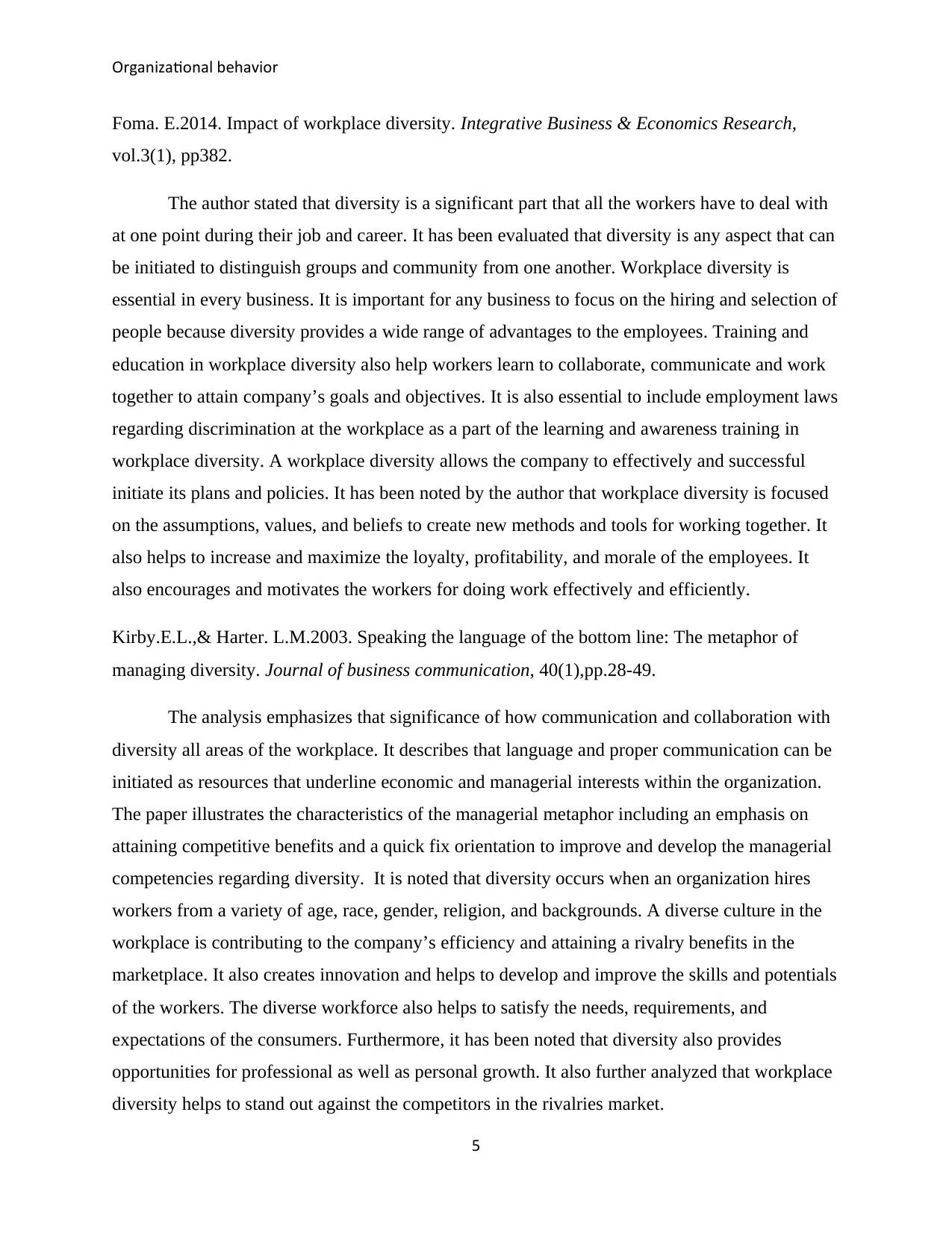
Organizational behavior
Foma. E.2014. Impact of workplace diversity. Integrative Business & Economics Research,
vol.3(1), pp382.
The author stated that diversity is a significant part that all the workers have to deal with
at one point during their job and career. It has been evaluated that diversity is any aspect that can
be initiated to distinguish groups and community from one another. Workplace diversity is
essential in every business. It is important for any business to focus on the hiring and selection of
people because diversity provides a wide range of advantages to the employees. Training and
education in workplace diversity also help workers learn to collaborate, communicate and work
together to attain company’s goals and objectives. It is also essential to include employment laws
regarding discrimination at the workplace as a part of the learning and awareness training in
workplace diversity. A workplace diversity allows the company to effectively and successful
initiate its plans and policies. It has been noted by the author that workplace diversity is focused
on the assumptions, values, and beliefs to create new methods and tools for working together. It
also helps to increase and maximize the loyalty, profitability, and morale of the employees. It
also encourages and motivates the workers for doing work effectively and efficiently.
Kirby.E.L.,& Harter. L.M.2003. Speaking the language of the bottom line: The metaphor of
managing diversity. Journal of business communication, 40(1),pp.28-49.
The analysis emphasizes that significance of how communication and collaboration with
diversity all areas of the workplace. It describes that language and proper communication can be
initiated as resources that underline economic and managerial interests within the organization.
The paper illustrates the characteristics of the managerial metaphor including an emphasis on
attaining competitive benefits and a quick fix orientation to improve and develop the managerial
competencies regarding diversity. It is noted that diversity occurs when an organization hires
workers from a variety of age, race, gender, religion, and backgrounds. A diverse culture in the
workplace is contributing to the company’s efficiency and attaining a rivalry benefits in the
marketplace. It also creates innovation and helps to develop and improve the skills and potentials
of the workers. The diverse workforce also helps to satisfy the needs, requirements, and
expectations of the consumers. Furthermore, it has been noted that diversity also provides
opportunities for professional as well as personal growth. It also further analyzed that workplace
diversity helps to stand out against the competitors in the rivalries market.
5
Foma. E.2014. Impact of workplace diversity. Integrative Business & Economics Research,
vol.3(1), pp382.
The author stated that diversity is a significant part that all the workers have to deal with
at one point during their job and career. It has been evaluated that diversity is any aspect that can
be initiated to distinguish groups and community from one another. Workplace diversity is
essential in every business. It is important for any business to focus on the hiring and selection of
people because diversity provides a wide range of advantages to the employees. Training and
education in workplace diversity also help workers learn to collaborate, communicate and work
together to attain company’s goals and objectives. It is also essential to include employment laws
regarding discrimination at the workplace as a part of the learning and awareness training in
workplace diversity. A workplace diversity allows the company to effectively and successful
initiate its plans and policies. It has been noted by the author that workplace diversity is focused
on the assumptions, values, and beliefs to create new methods and tools for working together. It
also helps to increase and maximize the loyalty, profitability, and morale of the employees. It
also encourages and motivates the workers for doing work effectively and efficiently.
Kirby.E.L.,& Harter. L.M.2003. Speaking the language of the bottom line: The metaphor of
managing diversity. Journal of business communication, 40(1),pp.28-49.
The analysis emphasizes that significance of how communication and collaboration with
diversity all areas of the workplace. It describes that language and proper communication can be
initiated as resources that underline economic and managerial interests within the organization.
The paper illustrates the characteristics of the managerial metaphor including an emphasis on
attaining competitive benefits and a quick fix orientation to improve and develop the managerial
competencies regarding diversity. It is noted that diversity occurs when an organization hires
workers from a variety of age, race, gender, religion, and backgrounds. A diverse culture in the
workplace is contributing to the company’s efficiency and attaining a rivalry benefits in the
marketplace. It also creates innovation and helps to develop and improve the skills and potentials
of the workers. The diverse workforce also helps to satisfy the needs, requirements, and
expectations of the consumers. Furthermore, it has been noted that diversity also provides
opportunities for professional as well as personal growth. It also further analyzed that workplace
diversity helps to stand out against the competitors in the rivalries market.
5
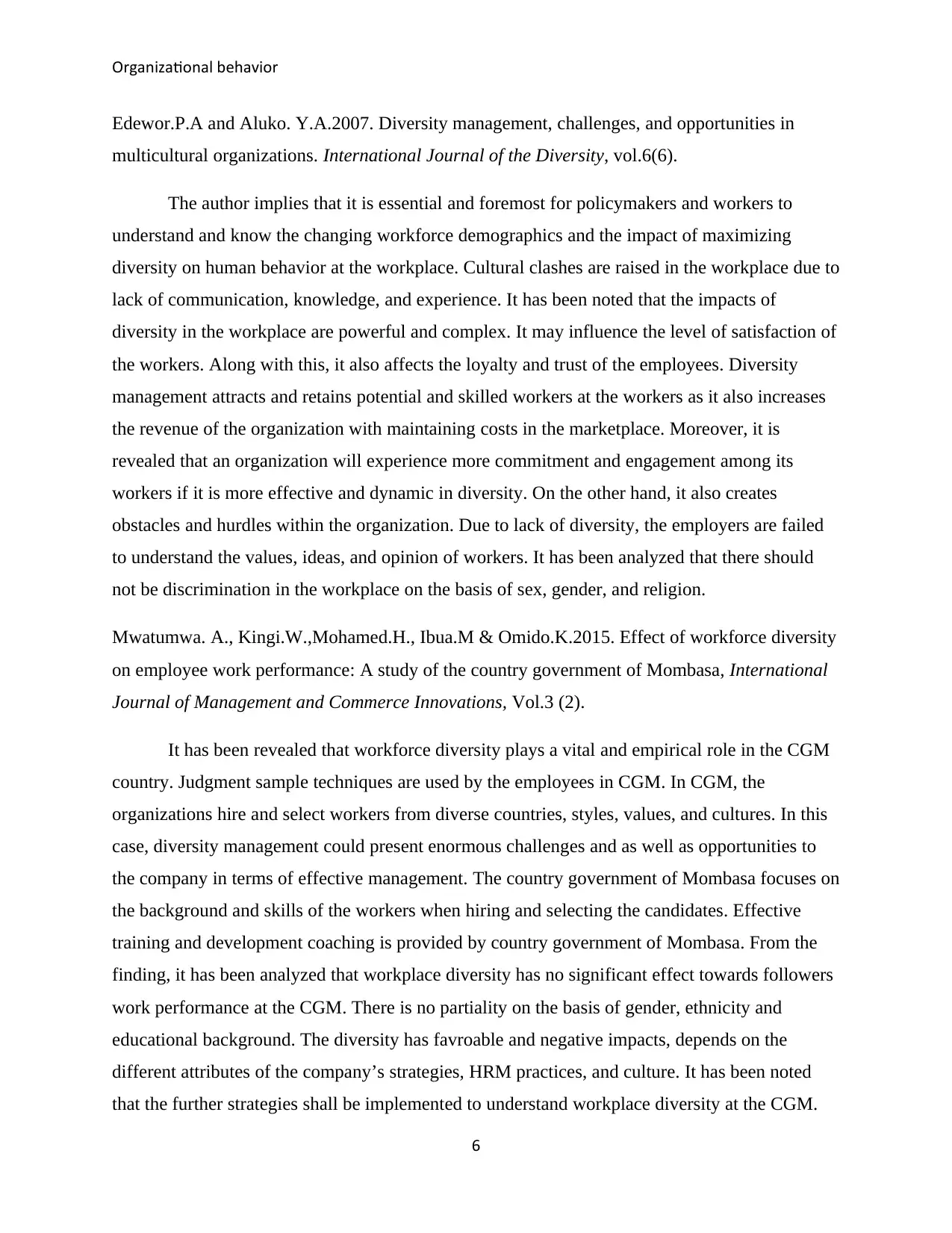
Organizational behavior
Edewor.P.A and Aluko. Y.A.2007. Diversity management, challenges, and opportunities in
multicultural organizations. International Journal of the Diversity, vol.6(6).
The author implies that it is essential and foremost for policymakers and workers to
understand and know the changing workforce demographics and the impact of maximizing
diversity on human behavior at the workplace. Cultural clashes are raised in the workplace due to
lack of communication, knowledge, and experience. It has been noted that the impacts of
diversity in the workplace are powerful and complex. It may influence the level of satisfaction of
the workers. Along with this, it also affects the loyalty and trust of the employees. Diversity
management attracts and retains potential and skilled workers at the workers as it also increases
the revenue of the organization with maintaining costs in the marketplace. Moreover, it is
revealed that an organization will experience more commitment and engagement among its
workers if it is more effective and dynamic in diversity. On the other hand, it also creates
obstacles and hurdles within the organization. Due to lack of diversity, the employers are failed
to understand the values, ideas, and opinion of workers. It has been analyzed that there should
not be discrimination in the workplace on the basis of sex, gender, and religion.
Mwatumwa. A., Kingi.W.,Mohamed.H., Ibua.M & Omido.K.2015. Effect of workforce diversity
on employee work performance: A study of the country government of Mombasa, International
Journal of Management and Commerce Innovations, Vol.3 (2).
It has been revealed that workforce diversity plays a vital and empirical role in the CGM
country. Judgment sample techniques are used by the employees in CGM. In CGM, the
organizations hire and select workers from diverse countries, styles, values, and cultures. In this
case, diversity management could present enormous challenges and as well as opportunities to
the company in terms of effective management. The country government of Mombasa focuses on
the background and skills of the workers when hiring and selecting the candidates. Effective
training and development coaching is provided by country government of Mombasa. From the
finding, it has been analyzed that workplace diversity has no significant effect towards followers
work performance at the CGM. There is no partiality on the basis of gender, ethnicity and
educational background. The diversity has favroable and negative impacts, depends on the
different attributes of the company’s strategies, HRM practices, and culture. It has been noted
that the further strategies shall be implemented to understand workplace diversity at the CGM.
6
Edewor.P.A and Aluko. Y.A.2007. Diversity management, challenges, and opportunities in
multicultural organizations. International Journal of the Diversity, vol.6(6).
The author implies that it is essential and foremost for policymakers and workers to
understand and know the changing workforce demographics and the impact of maximizing
diversity on human behavior at the workplace. Cultural clashes are raised in the workplace due to
lack of communication, knowledge, and experience. It has been noted that the impacts of
diversity in the workplace are powerful and complex. It may influence the level of satisfaction of
the workers. Along with this, it also affects the loyalty and trust of the employees. Diversity
management attracts and retains potential and skilled workers at the workers as it also increases
the revenue of the organization with maintaining costs in the marketplace. Moreover, it is
revealed that an organization will experience more commitment and engagement among its
workers if it is more effective and dynamic in diversity. On the other hand, it also creates
obstacles and hurdles within the organization. Due to lack of diversity, the employers are failed
to understand the values, ideas, and opinion of workers. It has been analyzed that there should
not be discrimination in the workplace on the basis of sex, gender, and religion.
Mwatumwa. A., Kingi.W.,Mohamed.H., Ibua.M & Omido.K.2015. Effect of workforce diversity
on employee work performance: A study of the country government of Mombasa, International
Journal of Management and Commerce Innovations, Vol.3 (2).
It has been revealed that workforce diversity plays a vital and empirical role in the CGM
country. Judgment sample techniques are used by the employees in CGM. In CGM, the
organizations hire and select workers from diverse countries, styles, values, and cultures. In this
case, diversity management could present enormous challenges and as well as opportunities to
the company in terms of effective management. The country government of Mombasa focuses on
the background and skills of the workers when hiring and selecting the candidates. Effective
training and development coaching is provided by country government of Mombasa. From the
finding, it has been analyzed that workplace diversity has no significant effect towards followers
work performance at the CGM. There is no partiality on the basis of gender, ethnicity and
educational background. The diversity has favroable and negative impacts, depends on the
different attributes of the company’s strategies, HRM practices, and culture. It has been noted
that the further strategies shall be implemented to understand workplace diversity at the CGM.
6
⊘ This is a preview!⊘
Do you want full access?
Subscribe today to unlock all pages.

Trusted by 1+ million students worldwide
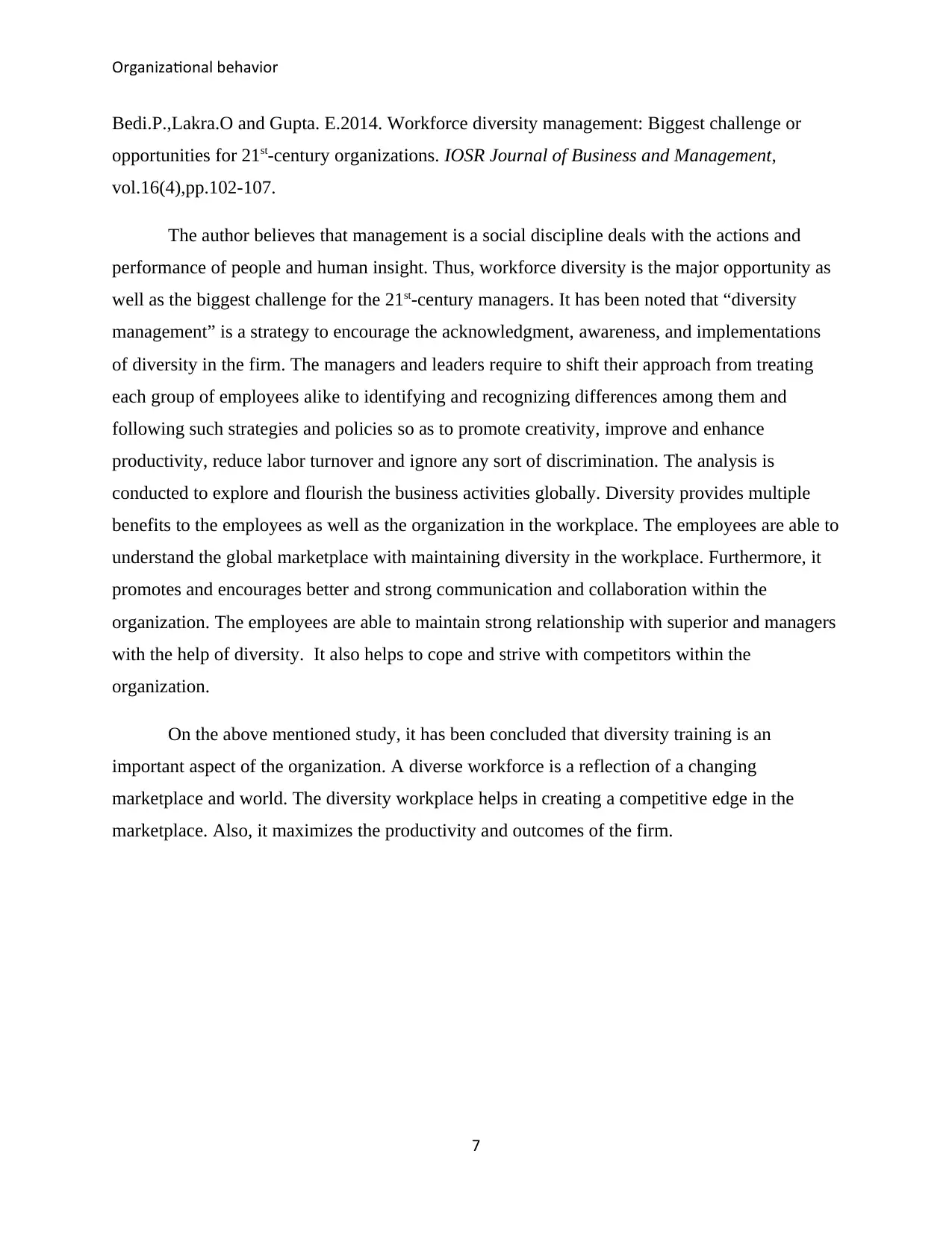
Organizational behavior
Bedi.P.,Lakra.O and Gupta. E.2014. Workforce diversity management: Biggest challenge or
opportunities for 21st-century organizations. IOSR Journal of Business and Management,
vol.16(4),pp.102-107.
The author believes that management is a social discipline deals with the actions and
performance of people and human insight. Thus, workforce diversity is the major opportunity as
well as the biggest challenge for the 21st-century managers. It has been noted that “diversity
management” is a strategy to encourage the acknowledgment, awareness, and implementations
of diversity in the firm. The managers and leaders require to shift their approach from treating
each group of employees alike to identifying and recognizing differences among them and
following such strategies and policies so as to promote creativity, improve and enhance
productivity, reduce labor turnover and ignore any sort of discrimination. The analysis is
conducted to explore and flourish the business activities globally. Diversity provides multiple
benefits to the employees as well as the organization in the workplace. The employees are able to
understand the global marketplace with maintaining diversity in the workplace. Furthermore, it
promotes and encourages better and strong communication and collaboration within the
organization. The employees are able to maintain strong relationship with superior and managers
with the help of diversity. It also helps to cope and strive with competitors within the
organization.
On the above mentioned study, it has been concluded that diversity training is an
important aspect of the organization. A diverse workforce is a reflection of a changing
marketplace and world. The diversity workplace helps in creating a competitive edge in the
marketplace. Also, it maximizes the productivity and outcomes of the firm.
7
Bedi.P.,Lakra.O and Gupta. E.2014. Workforce diversity management: Biggest challenge or
opportunities for 21st-century organizations. IOSR Journal of Business and Management,
vol.16(4),pp.102-107.
The author believes that management is a social discipline deals with the actions and
performance of people and human insight. Thus, workforce diversity is the major opportunity as
well as the biggest challenge for the 21st-century managers. It has been noted that “diversity
management” is a strategy to encourage the acknowledgment, awareness, and implementations
of diversity in the firm. The managers and leaders require to shift their approach from treating
each group of employees alike to identifying and recognizing differences among them and
following such strategies and policies so as to promote creativity, improve and enhance
productivity, reduce labor turnover and ignore any sort of discrimination. The analysis is
conducted to explore and flourish the business activities globally. Diversity provides multiple
benefits to the employees as well as the organization in the workplace. The employees are able to
understand the global marketplace with maintaining diversity in the workplace. Furthermore, it
promotes and encourages better and strong communication and collaboration within the
organization. The employees are able to maintain strong relationship with superior and managers
with the help of diversity. It also helps to cope and strive with competitors within the
organization.
On the above mentioned study, it has been concluded that diversity training is an
important aspect of the organization. A diverse workforce is a reflection of a changing
marketplace and world. The diversity workplace helps in creating a competitive edge in the
marketplace. Also, it maximizes the productivity and outcomes of the firm.
7
Paraphrase This Document
Need a fresh take? Get an instant paraphrase of this document with our AI Paraphraser
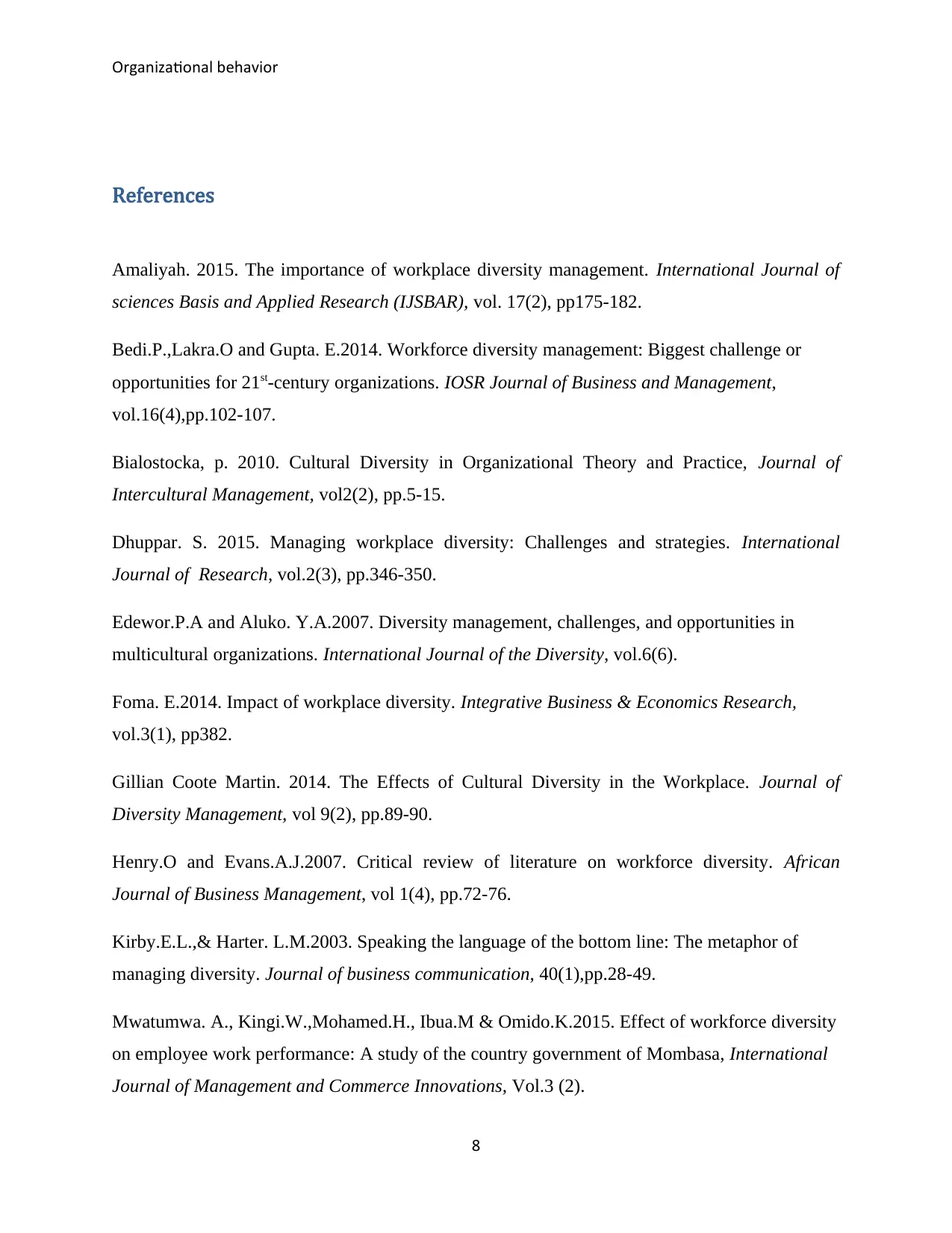
Organizational behavior
References
Amaliyah. 2015. The importance of workplace diversity management. International Journal of
sciences Basis and Applied Research (IJSBAR), vol. 17(2), pp175-182.
Bedi.P.,Lakra.O and Gupta. E.2014. Workforce diversity management: Biggest challenge or
opportunities for 21st-century organizations. IOSR Journal of Business and Management,
vol.16(4),pp.102-107.
Bialostocka, p. 2010. Cultural Diversity in Organizational Theory and Practice, Journal of
Intercultural Management, vol2(2), pp.5-15.
Dhuppar. S. 2015. Managing workplace diversity: Challenges and strategies. International
Journal of Research, vol.2(3), pp.346-350.
Edewor.P.A and Aluko. Y.A.2007. Diversity management, challenges, and opportunities in
multicultural organizations. International Journal of the Diversity, vol.6(6).
Foma. E.2014. Impact of workplace diversity. Integrative Business & Economics Research,
vol.3(1), pp382.
Gillian Coote Martin. 2014. The Effects of Cultural Diversity in the Workplace. Journal of
Diversity Management, vol 9(2), pp.89-90.
Henry.O and Evans.A.J.2007. Critical review of literature on workforce diversity. African
Journal of Business Management, vol 1(4), pp.72-76.
Kirby.E.L.,& Harter. L.M.2003. Speaking the language of the bottom line: The metaphor of
managing diversity. Journal of business communication, 40(1),pp.28-49.
Mwatumwa. A., Kingi.W.,Mohamed.H., Ibua.M & Omido.K.2015. Effect of workforce diversity
on employee work performance: A study of the country government of Mombasa, International
Journal of Management and Commerce Innovations, Vol.3 (2).
8
References
Amaliyah. 2015. The importance of workplace diversity management. International Journal of
sciences Basis and Applied Research (IJSBAR), vol. 17(2), pp175-182.
Bedi.P.,Lakra.O and Gupta. E.2014. Workforce diversity management: Biggest challenge or
opportunities for 21st-century organizations. IOSR Journal of Business and Management,
vol.16(4),pp.102-107.
Bialostocka, p. 2010. Cultural Diversity in Organizational Theory and Practice, Journal of
Intercultural Management, vol2(2), pp.5-15.
Dhuppar. S. 2015. Managing workplace diversity: Challenges and strategies. International
Journal of Research, vol.2(3), pp.346-350.
Edewor.P.A and Aluko. Y.A.2007. Diversity management, challenges, and opportunities in
multicultural organizations. International Journal of the Diversity, vol.6(6).
Foma. E.2014. Impact of workplace diversity. Integrative Business & Economics Research,
vol.3(1), pp382.
Gillian Coote Martin. 2014. The Effects of Cultural Diversity in the Workplace. Journal of
Diversity Management, vol 9(2), pp.89-90.
Henry.O and Evans.A.J.2007. Critical review of literature on workforce diversity. African
Journal of Business Management, vol 1(4), pp.72-76.
Kirby.E.L.,& Harter. L.M.2003. Speaking the language of the bottom line: The metaphor of
managing diversity. Journal of business communication, 40(1),pp.28-49.
Mwatumwa. A., Kingi.W.,Mohamed.H., Ibua.M & Omido.K.2015. Effect of workforce diversity
on employee work performance: A study of the country government of Mombasa, International
Journal of Management and Commerce Innovations, Vol.3 (2).
8

Organizational behavior
9
9
⊘ This is a preview!⊘
Do you want full access?
Subscribe today to unlock all pages.

Trusted by 1+ million students worldwide
1 out of 9
Related Documents
Your All-in-One AI-Powered Toolkit for Academic Success.
+13062052269
info@desklib.com
Available 24*7 on WhatsApp / Email
![[object Object]](/_next/static/media/star-bottom.7253800d.svg)
Unlock your academic potential
Copyright © 2020–2025 A2Z Services. All Rights Reserved. Developed and managed by ZUCOL.




